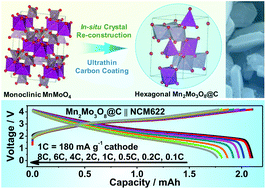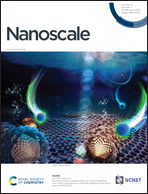Crystal reconstruction of binary oxide hexagonal nanoplates: monocrystalline formation mechanism and high rate lithium-ion battery applications†
Abstract
Structural design and/or carbon modification are the most important strategies to improve the performance of materials in many applications, where metal (oxide)-based anode design attracts great attention in metal ion batteries due to their high capacities. However, achieving these two goals within one-step remains challenging due to the lower cost and higher efficiency needed to satisfy the demand in practical application. Herein, we report a new approach for the crystal reconstruction of metal oxides by acetylene treatment, in which a hierarchical binary oxide decorated with carbon (i.e., Mn2Mo3O8@C) is introduced. The mechanism of constructing unique monocrystalline hexagonal nanoplates and uniform carbon coating is discussed in detail. Benefiting from the uniqueness of structure and composition, the Mn2Mo3O8@C demonstrates an extremely high lithium storage capacity of 890 mA h g−1 and good rate capacities at 20 A g−1 over 1000 cycles. In addition, the high rate capabilities and long cycle lifespan are further confirmed when the Mn2Mo3O8@C anode is matched with the nickel-rich layered oxide cathode. This study not only introduces a new binary oxide anode with high performances in lithium (ion) batteries but also presents a convenient methodology to design more advanced functional materials.

- This article is part of the themed collection: 2020 Nanoscale HOT Article Collection


 Please wait while we load your content...
Please wait while we load your content...